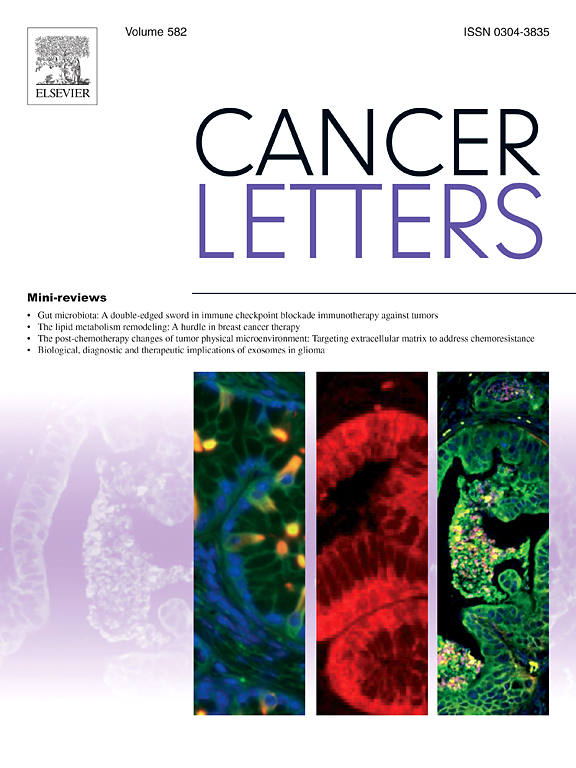癌症相关成纤维细胞衍生的双调节蛋白促进恶性鳞状细胞癌的进展和EGFR抑制剂的耐药性
IF 9.1
1区 医学
Q1 ONCOLOGY
引用次数: 0
摘要
在临床肿瘤学中,缺乏持续的治疗反应在癌症患者中很常见,这在很大程度上限制了大多数抗癌靶向治疗的效率。虽然抗egfr疗法已广泛应用于头颈部鳞状细胞癌(HNSCC)的治疗,但由于尚未解决的耐药机制,其临床疗效仍然有限。值得注意的是,EGFR配体蛋白在肿瘤进展和治疗反应中的功能作用尚未完全阐明。在这里,我们揭示了双调节蛋白(AREG)是恶性鳞癌患者egfr靶向治疗耐药的潜在驱动因素。我们发现PDGFRβ+FAP+αSMA+肌成纤维细胞(myCAF)亚群是肿瘤微环境中AREG的主要来源。TCGA数据库和临床队列显示,AREG高表达患者的淋巴结转移率(59.35%)明显较高,预后较差(中位5年生存期:2.2年)。相比之下,低AREG表达的患者转移潜力降低(转移率:45.16%),临床结果更有利(中位5年生存期:4.8年)。在机制上,AREG通过肿瘤细胞的上皮-内皮过渡促进血管模拟形成,提供额外的血液供应和转移通道。此外,活细胞成像显示,AREG诱导90%以上受体蛋白的质膜稳定,同时增强受体循环,驱动EGFR抑制剂的耐药性。总之,我们的研究揭示了AREG在肿瘤景观中的关键作用,为EGFR抑制剂效率的新预测生物标志物以及HNSCC的新潜在治疗靶点提供了信息。本文章由计算机程序翻译,如有差异,请以英文原文为准。
Cancer-associated fibroblasts derived amphiregulin promotes HNSCC progression and drug resistance of EGFR inhibitor
In clinical oncology, lack of sustained treatment response is very common in cancer patients and largely limits the efficiency of most anticancer targeted-therapies. While anti-EGFR therapeutics have been extensively employed in head and neck squamous cell carcinoma (HNSCC) management, their clinical efficacy remains limited due to unresolved resistance mechanisms. Notably, the functional role of EGFR ligand proteins in both tumor progression and therapeutic response has not been fully elucidated. Here we reveal that amphiregulin (AREG) as a potential driver of drug resistance of EGFR-targeted treatment in HNSCC patients. We identify a PDGFRβ+FAP+αSMA+ myofibroblast (myCAF) subset as the major source of AREG in tumor microenvironment. TCGA database and clinical cohort demonstrated that patients with high AREG expression exhibited significantly higher lymph node metastasis rates (59.35 %) and poorer prognosis (median 5-year survival: 2.2 years). In contrast, patients with low AREG expression showed reduced metastatic potential (metastasis rate: 45.16 %) and more favorable clinical outcomes (median 5-year survival: 4.8 years). Mechanistically, AREG promotes vascular mimicry formation via epithelial-endothelial transition of tumor cells to offer extra blood supply and metastasis channels. Further, live-cell imaging revealed that AREG induces plasma membrane stabilization of over 90 % receptor proteins while concurrently enhancing receptor recycling, driving EGFR inhibitor resistance. Collectively, our study reveals the crucial role of AREG in tumor landscape, informing a new predictive biomarker of EGFR inhibitor efficiency as well as a new potential therapeutic target of HNSCC.
求助全文
通过发布文献求助,成功后即可免费获取论文全文。
去求助
来源期刊

Cancer letters
医学-肿瘤学
CiteScore
17.70
自引率
2.10%
发文量
427
审稿时长
15 days
期刊介绍:
Cancer Letters is a reputable international journal that serves as a platform for significant and original contributions in cancer research. The journal welcomes both full-length articles and Mini Reviews in the wide-ranging field of basic and translational oncology. Furthermore, it frequently presents Special Issues that shed light on current and topical areas in cancer research.
Cancer Letters is highly interested in various fundamental aspects that can cater to a diverse readership. These areas include the molecular genetics and cell biology of cancer, radiation biology, molecular pathology, hormones and cancer, viral oncology, metastasis, and chemoprevention. The journal actively focuses on experimental therapeutics, particularly the advancement of targeted therapies for personalized cancer medicine, such as metronomic chemotherapy.
By publishing groundbreaking research and promoting advancements in cancer treatments, Cancer Letters aims to actively contribute to the fight against cancer and the improvement of patient outcomes.
 求助内容:
求助内容: 应助结果提醒方式:
应助结果提醒方式:


